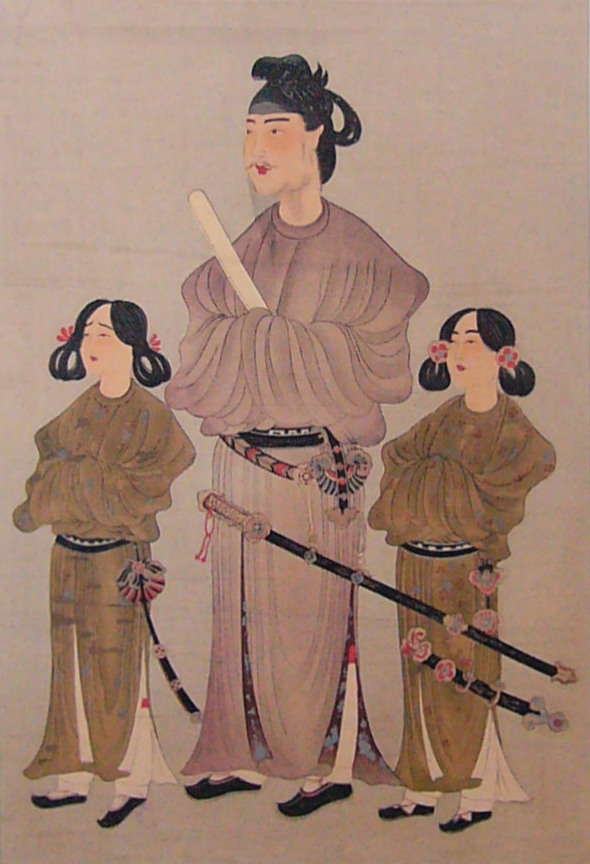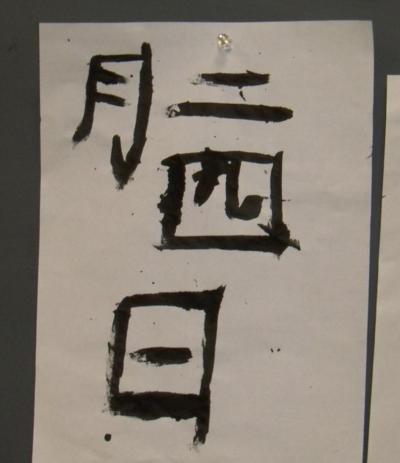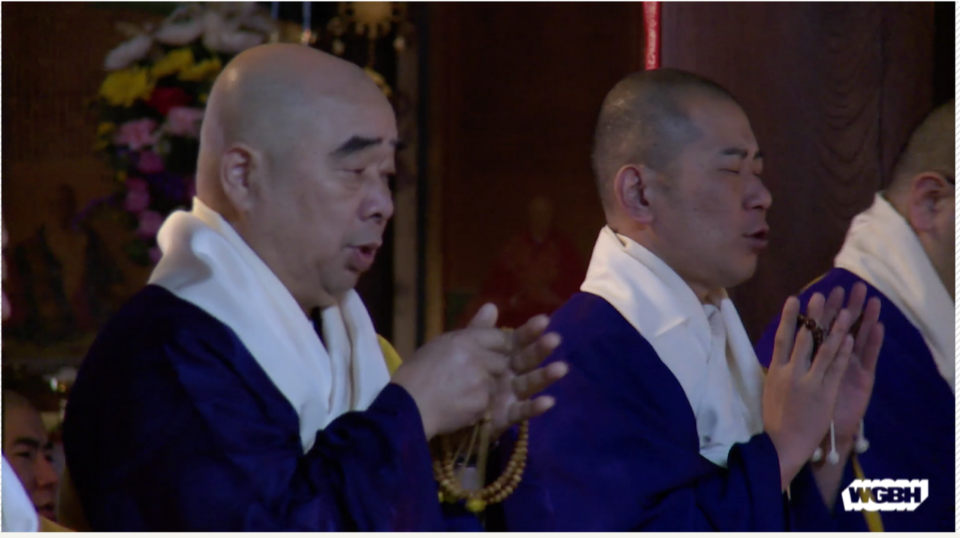Chinese Influences on Japan
Chinese Influences on Japan
This complete module with links to all materials may be downloaded as a PDF here.
Rebecca Byrd
New Center Elementary
Sevierville, Tennessee

Prince ShÅtoku with his two sons, Prince Eguri (left) and Prince Yamashiro (right). Source: Wikipedia at https://tinyurl.com/ycg7k95m.
This module was developed for a seventh-grade world history and geography class, specifically to address Tennessee standard 7.09ââExplain how Japanese culture changed through Chinese and Korean influences (including Buddhism and Confucianism) as shown in the Constitution of Prince ShÅtoku and the adoption of the Chinese writing system.â
However, part or all of the module is applicable to middle school world history and/or geography classes elsewhere if early Japanese history is part of the curriculum.
Estimated module length: Two ninety-minute class periods
Overview
China was the first Northeast Asian culture to develop a written language, which was transmitted, along with Chinese cultural practices, to the peninsula we know today as Korea. The country that became Japan was the last large regional polity to acquire written Chinese and other aspects of Chinese culture. Although Chinese records indicated that a government mission visited what is today Japan approximately fifty-seven years before the Common Era, evidence of the Chinese writing system appearing on the Japanese archipelago dates back to sometime between the second and third centuries CE. The purpose of this module is to introduce students to significant early Chinese influences on Japan.
Objectives
Students will:
Identify aspects of Japanese culture such as government, language, and religion that were influenced by contact with Korea and China.
Explain how and why the Japanese assimilated aspects of Chinese culture.
Explain how Japanese written language (kanji, hiragana, katakana) evolved from Chinese.
Analyze the Constitution of Prince ShÅtoku to identify Buddhist and Confucian influences and explain the constitutionâs significance.
Prerequisite knowledge
Students will need to know the basic principles of Buddhism and Confucianism. They will also need to understand the meaning of the concept âimperial bureaucracyâ in China. Finally, a familiarity with the Sui and Tang (Tâang) dynasties will help students identify Chinese influences on Japanese culture.
Introductory activity
Estimated time: ten minutes
Students will be asked to generate a list of words they believe are Japanese in origin, and then the class will determine the connections between the words. Example: Sushi and hibachi are both related to food. The Fluent U Japanese language and culture blog post, linked here, has a list of words that would be familiar to most students
Ask students to consider how the Japanese words from the list came to be used in United States.
Explain to students that trade, cultural exchange, and military encounters are often avenues through which language is shared.
Show students a map of East Asia. Have them hypothesize which countries would likely share language or other aspects of culture with Japan.
Authorâs note on class discussion
Students were able to generate a list of twenty Japanese words, including samurai, katana, tsunami, sushi, and haiku. Students immediately thought of five words but needed a few minutes of wait time to think of additional words, including ShintÅ, sumo, anime, and karaoke. Students were quickly able to name trade and entertainment as reasons for Japanese words to enter American English. Students needed some gentle prompting to remind them about the presence of U.S. military personnel in Japan since World War II. I found it useful to personalize this part of the lesson with anecdotes about my aunt, who worked for a Japanese company in the early 1980s, and a friend who served in the Navy and was stationed in Japan for a few months. Students were then able to make their own connections with the words and share their own anecdotes.
Class No. 1
Activity No. 1: Development of the Japanese written language
Estimated time: thirty-five minutes
Show the Asia For Educatorsâ (AFE) videos âFour Elements Borrowed from Chinaâ (forty-nine seconds) and âJapanese Use of the Chinese Writing Systemâ (four minutes, twenty-five seconds).
After viewing both videos, discuss the following key points with students:
Chinese was the first and only written language known in Japan.
At first, all Japanese government documents and histories were written solely in Chinese.
In the late ninth and early tenth centuries, syllabaries called kana were adapted from Chinese characters that allow Japanese words and foreign loanwords to be written.
As spoken languages, Japanese and Chinese are very different, so using Chinese characters to write a number of Japanese words was not a practical choice.
Next, have students read the AFE essay âThe Written Language.â After students read, have them generate a list of key ideas about Japanâs writing systems. The list should include the key points above, as well as additional points:
Japanese has three separate sets of symbols for writing: kanji, hiragana, and katakana.
Kanji: Thousands of characters borrowed from Chinese writing, each with a different meaning
Hiragana: Forty-six "smooth"-style phonetic symbols used for inflected endings, grammatical particles, and other Japanese words
Katakana: Forty-six "block"-style phonetic symbols used for writing foreign loanwords, foreign names, and for emphasis
Students must learn 881 kanji in elementary school and a total of 1,850 by the time they graduate from high school.
Having symbols that indicate both sound and meaning gives the language flexibility
Authorâs note on class discussion: After viewing the videos and reading the essay, students were able to articulate most of the main points noted above. They were shocked to learn that elementary students have to master 881 kanji. Students spent some time discussing the merits of having twenty-six letters in English versus thousands of characters in Japanese. Most students thought English was much easier. One student pointed out that English has many blends that have to be represented by more than one sound, as well as letters that are silent and spelling rules with multiple exceptions. Following her comment, the class consensus was that both languages have their own unique challenges for learners. One student quipped that that he was going to stop complaining to his English teacher. Students also noted that Japanese may be written vertically or horizontally, which they found very unique.
Activity No. 2: Writing kanji
Estimated time: forty-five minutes
Print out copies of the kanji exercise found here. If students have access to tablets or laptops, you may provide them with the link to the exercise. This will allow them to zoom in on the symbols, which can be very helpful. Have students complete as many of the classroom exercises as time allows. You may wish to provide students with unlined paper for their practice exercises.
This activity can be completed in the classroom using markers or just ordinary pencils on paper. However, if you can arrange for students to use calligraphy brushes, ink and calligraphy paper, it will add a great deal to student understanding and enjoyment of the lesson. Brushes, ink and paper can be purchased economically from a number of sources. You do not necessarily need a brush for each student. You may want to set up five or six stations with brushes, ink and paper. Have students practice the exercises at their desks using pencils. You can monitor their progress and send students to the ink stations in groups. This procedure will take slightly longer but will allow you to closely monitor the use of ink. Remember to tell students to wear old clothes for this lesson, or provide them with aprons or smocks to protect their clothing.



Images of the kanji activity in class.
Source: Photos courtesy of the author.
Class No. 2
Activity No. 1: Japan timeline
Estimated time: fifteen minutes
Divide students into teams of two or three. Give each team an event from the timeline. Have students determine what, if any, Chinese influence is evident in the event. Have students organize themselves chronologically, read the event, and then share the Chinese influence on the event.
Note: All the events reflect a direct or indirect influence of Chinese culture in terms of language, government, arts, or religionâspecifically Buddhism.
Authorâs note
A great way to connect the timeline activity to the reading in Activity No. 2 is to compare Japanâs relationship to China to that of siblings. I asked my students how many of them had younger siblings. (About half the class raised their hands.) Next, I asked if their younger siblings ever tried to copy their behavior. Several students shared responses, including trying to play basketball, copying their hairstyles, and borrowing clothing without permission. I told students that their younger siblings copied them because they admired their older brothers and sisters, and that Japan copied or borrowed aspects of Chinese culture for the same reason.
Activity No. 2: Japanese missions to the Chinese court
Estimated time: fifteen minutes
Students will read the Japan Society article âJapanese Missions to China,â adapted from an essay by Doug Fuqua. After reading the article, students should discuss the following questions:
Why did Japan begin the missions to China?
What aspects of Chinese culture did the Japanese assimilate?
Why did Japan stop the trade missions?
Authorâs note on class discussion
Students were able to generate answers to all three questions in small groups and report to the class. I had students list the assimilated aspects of culture on the whiteboard to create a master class list. The student-generated list included Buddhism, architecture, tax system, written language, and ideas about governance
Activity No. 3: Buddhism and Confucianism review
Estimated time: twenty minutes
Before analyzing Prince ShÅtokuâs Constitution, students should review key aspects of Buddhism and Confucianism. You may wish to show the short videos âThe Evolution of Buddhism in Japanâ (three minutes and seven seconds) and âDiscovering ChinaâConfuciusâ (four minutes and twenty seven seconds) before reviewing the key aspects of Buddhism and Confucianism listed below.

Screen capture from âThe Evolution of Buddhism.â Source: PBS Learning Media at https://tinyurl.com/ybme5tll.
Key aspects of Buddhism
Life is suffering; suffering comes from desiring what one does not have.
Liberation from suffering allows one to exit the cycle of rebirth.
Buddhism encourages wisdom, ethical conduct, and mental discipline.
Key aspects of Confucianism
Confucianism emphasizes the need for an orderly society.
Rulers should be virtuous.
Filial piety, or respect for oneâs parents, elders, and ancestors, is a key virtue.
Filial piety also requires subjects to respect their rulers.
Confucius emphasized education.
The civil service exam developed out of Confucian ideas of the need for educated and virtuous leadership.
Activity No. 4: Prince ShÅtokuâs Constitution
Estimated time: twenty minutes
Distribute copies of the Prince ShÅtokuâs Constitution handout to students. You may wish to have students read and discuss each of the points before they begin to answer the questions. This can be assigned individually but works best as a small group activity. An answer key is included.
Activity No. 5: Assessment
Estimated time: twenty minutes
Have students write a short response (two to three paragraphs) to the following prompt: How did Japanese culture change as a result of Chinese influences?
Students should include specific examples from both lessons. The rubric below may be used as a scoring guide.
|
4 |
3 |
2 |
1 |
|
Student provides specific examples of the assimilation of written language, Buddhism, and Confucianism by the Japanese, as well as how the culture exchange occurred. |
Student provides specific examples of the assimilation of written language, Buddhism, and Confucianism by the Japanese. |
Student provides specific examples of the assimilation of two of the following: written language, Buddhism, or Confucianism by the Japanese. |
Student provides specific examples of the assimilation of one of the following: written language, Buddhism, or Confucianism by the Japanese. |
References and resources
https://www.fluentu.com/blog/japanese/japanese-loanwords-in-english/: This is a link to Poppy Reidâs â32 Cool Japanese Loanwords We All Use in Englishâ from Fluent U.
http://afe.easia.columbia.edu/at/cl_japan/cj03.html: This is a link to Robert Oxnamâs âFour Elements Borrowed from Chinaâ from âAsian Topicsâ at Asia for Educators, Columbia University.
http://afe.easia.columbia.edu/at/cl_japan/cj09.html: This is a link to Robert Oxnamâs âJapanese Use of Chinese Writing Systemâ from âAsian Topicsâat Asia for Educators, Columbia University.
http://afe.easia.columbia.edu/special/japan_600ce_language.htm#written: This link takes you to Dr. Amy Vladeck Heinrichâs âThe Written Languageâ from Asia for Educators.
http://afe.easia.columbia.edu/special/japan_600ce_kanji.htm: This is a link to âChinese Characters: Kanjiâ from Asia for Educators.
https://www.metmuseum.org/toah/ht/06/eaj.html: This is the âHeilbrunn Timeline of Art History, Japan 500Ââ1000 A.D.,â from the Metropolitan Museum of Art.
http://aboutjapan.japansociety.org/content.cfm/the_japanese_missions_to_tang_china_7th-9th_centuries#sthash.gl42EVYe.dpbs: This is the link for Doug Fuquaâs âThe Japanese Missions to Tang China, 7thâ9th Centuriesâ from the Japan Society.
https://www.pbslearningmedia.org/resource/sj14-soc-buddhism/the-evolution-of-buddhism-in-japan/#.WwHti0gvzIV: âThe Evolution of Buddhism in Japanâ from PBS Learning Media is available here.
https://www.youtube.com/watch?v=RaYWBMAWPGQ: This is a link to Discovering Chinaâs âDiscovering ChinaâConfuciusâ from YouTube.
http://afe.easia.columbia.edu/ps/japan/ShÅtoku.pdf: âThe Constitution of Prince ShÅtokuâ from Asia for Educators is available here.